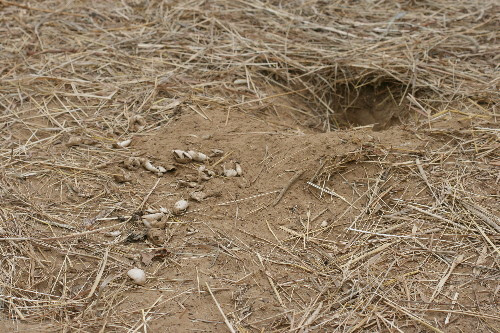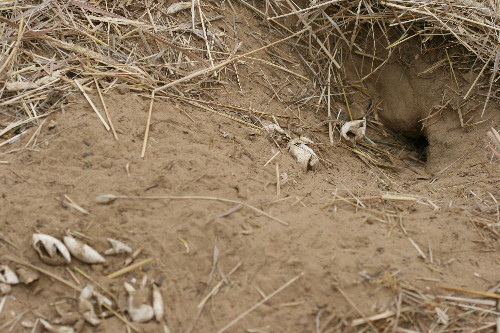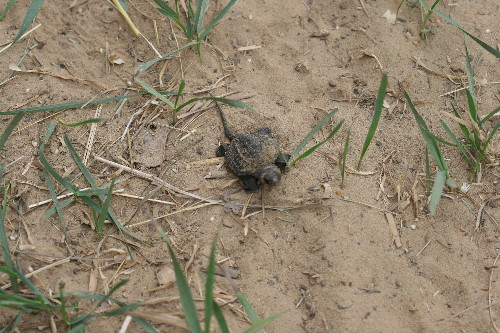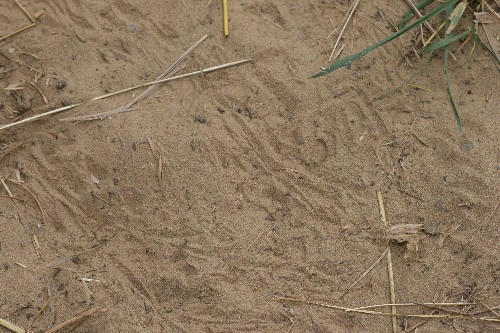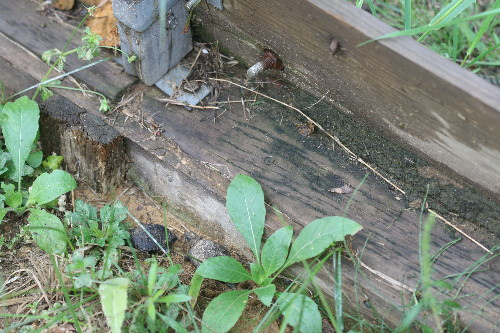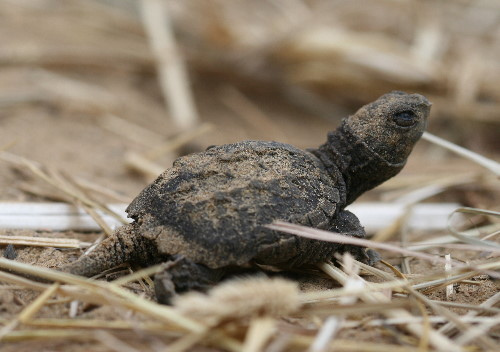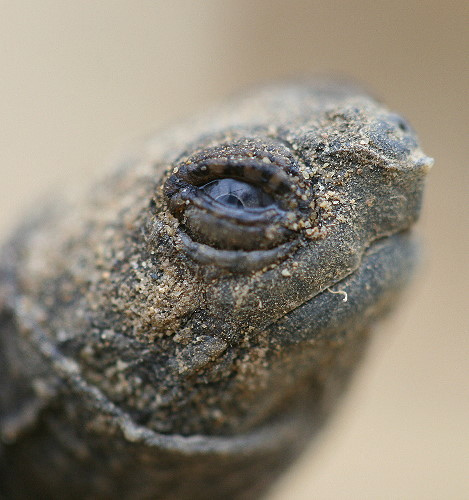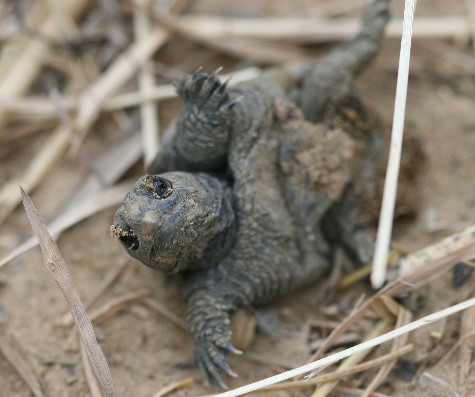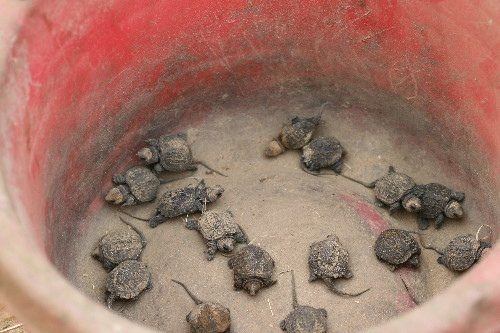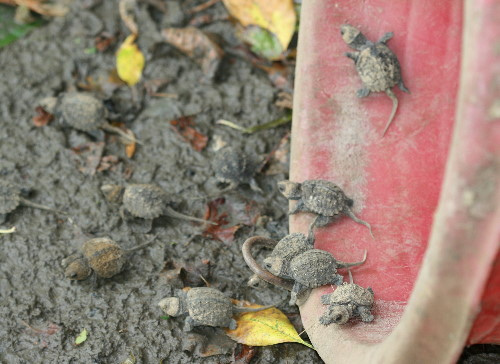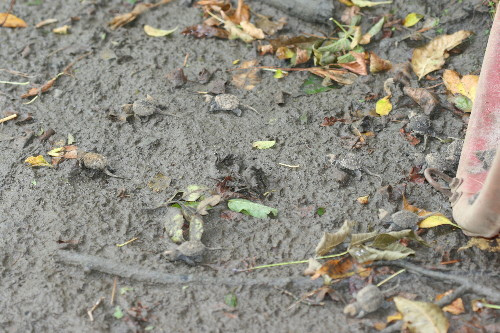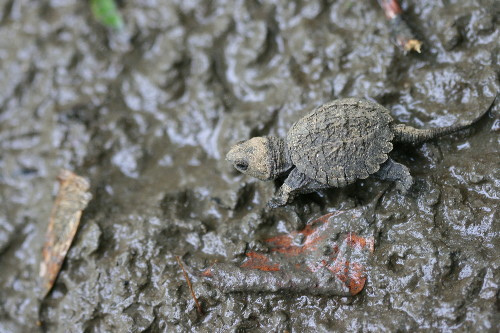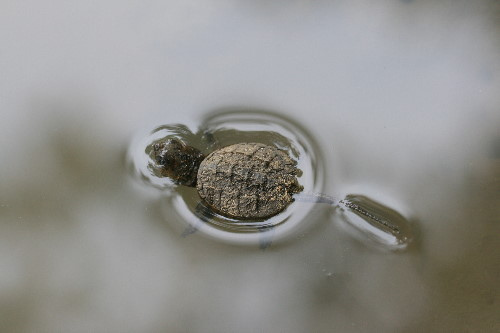Turtlets
30 Σεπτεμβρίου 2010
I’m housesitting for my parents this week, while they cavort about southern Pennsylvania. I’m here primarily to look after the horses, which are a little like dogs in that they require daily care, but are a lot harder to leave with a friend or take to a boarding kennel. My mom brings hers inside at night, into a hoop-style greenhouse that’s been converted into a stable. The original “floor” of the greenhouse is sand, though mats have been put down in the stalls.
First thing after I get up, before I even sit down with my own breakfast (because I tend to dawdle over breakfast, browsing the ‘net), I go out to put the horses out. Clearly I’m in a bit of an early-morning haze still, as I didn’t immediately notice the above in the floor; I’d already passed by it once before seeing it. My first thought was oh, raccoons found a turtle nest, what a shame. My second thought was hey, isn’t it neat that a turtle laid her eggs in here – certainly a great location.
And my third thought was, wait a minute… something’s not quite right for a raccoon predation. The hole’s too small for what I’d expect. And there’re no obvious claw marks. Plus the eggshells don’t look quite right.
And then I spotted this guy:
Sitting in the grass shoots right beside the path I’d come in along. How the heck had I missed it? No wonder the hole didn’t look right for a raccoon – the baby turtles had actually hatched!
I looked around: tracks everywhere, criss-crossing back and forth over the soft sand. Look closely and you can see the footprints on either side of the central tail line. I started paying more attention, and then I noticed another baby turtle, and then a third.
They seemed to have hatched in the middle of the night, and had had some time to make it up and down the stable corridor. Most probably, if everything had gone according to plan, the baby turtles would be long gone by the time I got there in the morning, and all I would’ve found would be the empty nest. But the greenhouse hoops are affixed to a wooden frame, which created a four-inch (10cm) tall barrier that stopped the turtlets up short. I don’t know if mama turtle came in over this wooden ledge – it wouldn’t’ve been much of an impediment for her size and strength – or if she came through one of the two doors at the ends, which I’d had closed and locked for the night. Either way, the baby turtles weren’t going anywhere.
I dashed back to the house to get my camera. They were especially obliging. Nobody was moving about anymore – exhausted from crawling all night? Or just by nature more sleepy during the day? Although I wouldn’t go anywhere near the business end of an adult snapping turtle (and I’d even approach the back end with caution, they’ve got incredible reach with that long neck), the jaws on these little babies were so tiny there wasn’t any threat even if they did try to bite.
As it was, they were very quiet and non-aggressive, very much unlike more mature individuals I’ve encountered at roadsides. When I picked them up they pulled their heads in and wrapped their tail about their feet. After a few moments, this one seemed relaxed enough to stick its head out again.
I don’t know if it’s possible to sex baby snapping turtles at this young age, and I didn’t try looking. I do know, however, that the sex of turtles is determined by the incubation temperature. Very high (over 30°C/86°F) or low (under 20°C/68°F) average temperatures result in almost exclusively females, while intermediate ranges produce males. At least four hours a day is required at the max temperature. Interestingly, because eggs aren’t all buried at the same depth, temperature within a nest can be stratified, with eggs at the top being considerably warmer than those at the bottom, resulting in mixed-sex nests.
This nest didn’t look very deep, and considering that it was in a greenhouse where the temperature escalates in the mid-summer sun, my suspicion is that they were all females. Females of many turtle species will return to the place where they hatched once they’re finally old enough to mate themselves. Wouldn’t it be neat to have them come back? Of course, something would have to be done about that wooden ledge.
This individual seemed to have had a run-in with something. A sibling? A mouse? It was missing its tail, the remaining stump a little bloody, although the rest of it seemed okay. However, whenever it got flipped over (as it was when I found it) it was unable to right itself. Snapping turtles have very long tails, and clearly they play an important part in turning over. I wonder if they’re used for stability in walking or as a rudder in the water – either way, almost certainly the handicap means this baby will be among the early mortalities. (The expression on her face clearly says, “Well? Don’t just sit there snapping photos, help me up!”)
I couldn’t let the horses out while there were baby turtles in the aisle (how often does that sentence get said?), so I grabbed a bucket and started collecting them up. I spent about fifteen minutes going up and down the aisle, checking in the weeds growing at the edges, amongst the loose hay, in all the corners, even peeked in the stalls to see if any might have slipped under the door (didn’t look like it). I gathered a total of 20 by the time I felt I’d found them all.
Meanwhile, the horses were getting impatient. What the heck was taking so long? They wanted out! They’d whicker at me in annoyance: Mother never keeps us waiting. When the turtles were out of harm’s way I finished with the horses, then did one last sweep of the aisle before walking the bucket down to the river.
I wasn’t sure where the best place to release them was. In the wet meadow? By the pond? Down by the river? I finally opted for the river because it was the easiest to access from where I was, plus I figured that the sandy banks were probably closer to a normal nesting location by which the turtlets could orient themselves. I tipped the bucket over to let them leave it on their own.
They hurried out, fanning out from the bucket but all invariably heading toward the water.
They were a bit apprehensive about me standing and watching, but a couple of the braver turtlets moved purposefully forward anyway. They were so light that the muddy bank edge that sucked at my shoes with wet gloppy noises was of no consequence to them.
Two reached the water while I stood and watched. I was a bit surprised to see that the surface tension was strong enough to keep them buoyed; I’m not sure if this was due to the extra sand on their shells, or if they’re normally just very light. I popped these two under the water to break the tension, and they paddled about – one came back to the shore and stuck its nose out, while the other swam away and out of sight.
I left the rest of them; at the rate they were going, put off by my presence as they were, it would take them a while to reach the water or wherever they wanted to go, and I had work to get back to. Turtlet survival is pretty low through their first year, so probably most of these little ones won’t make it anyway, but I felt they would be reasonably safe where I left them for as long as it took for them to reach the water, anyway. Maybe, in a few years, one or two will return.
Source: http://themarvelousinnature.wordpress.com/2010/09/07/turtlets/

